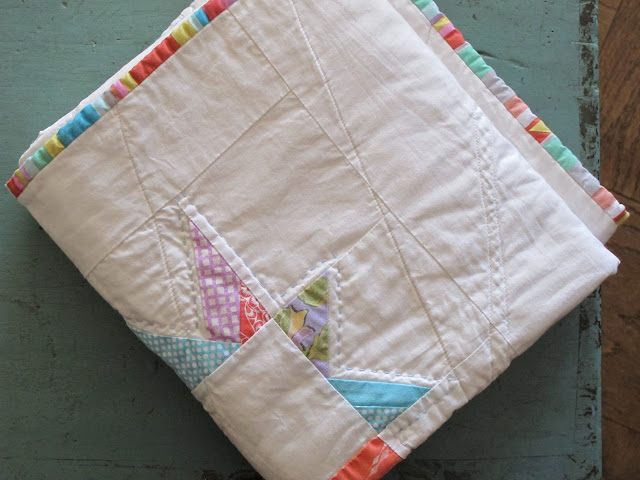When I'm sewing, sometimes I like to make things that are very neat and precise.
Other times, however, the freedom of a crazy, possibly wonky, spontaneous design is my favorite thing.
Like these
improv chevrons!
I'd estimate that a good portion of all handmade items are the result of a "
I-want-to-make-that" impulse that occurs while browsing at onnnnee store in particular. Yes, the girly-boho-rustic mecca: Anthropologie. As I'm no stranger to that impulse, these chevrons are inspired by this pillow I saw there.
Here's how I did it! This is more of a technique than a formal tutorial, as no two blocks will ever be the same.
Materials:
Strips of fabric between 1 and 3 inches wide. A variety of widths is best! I started by cutting a couple of strips from the long side of a fat quarter from about 8 different fabrics, and then cutting more if needed.
1. I built these chevrons from small end to fat end. Start with a small square or rectangle, and sew on strips to one corner, like a log cabin block. For improv piecing, I like to leave a little extra at the end, and don't worry about measuring or super-straight cuts. When sewing, I use the edge of the top fabric as a stitching guide even if the fabrics on the bottom don't line up perfectly.
2. Press open, repeat!
3. Once I have 3-4 rows of chevrons, I start to think about how I want my chevron section to look. This one will taper from small to large horizontally across the block, and create the center section. If it suits you, you can use a disappearing ink pen (or any marking tool you like) to mark where you'll eventually cut. First mark a vertical line to mark where the edge of the square will be. Then, choosing any angle you like, draw two lines radiating out from that across the block.
Like a paper or fabric foundation, this ensures two things: that you'll use enough fabric to cover the necessary area, and also that there's not a lot of fabric waste. Imagine if the rows just got bigger and bigger! That would probably look cool too, though, come to think of it. You can also do this part in your head, but I find that it really helps to have a clear idea of how long the additional strips need to be.
4. Continue until your block section reaches a width that's about 1/2-1 inches bigger than your desired size. In this case, I wanted to create a 14.5 inch block, so I stopped around 15 inches and drew another vertical line to mark the endpoint. This also helped me visualize where I needed to add more fabric to complete the left-side corners of the chevron section. At this point, I trimmed along my marked lines, and then filled in the corners.
5. Fill in the corner gaps, and trim again! One corner might need more fabric than the other.
6. The next two chevron sections will form the top and bottom of the block. Unlike the first section, they'll need to have square outer edges. I like to use my cutting mat lines (worn as they are) to visualize just where the chevron section has to go, and how big it needs to get. Sew a few strips together before lining up and marking.
Give yourself at least 1/2 inch more than you think you need in vertical space to allow for squaring up and a seam allowance. If there's not enough space for a full V shape at first, that's ok! Keep going!
If you see your chevrons heading in the wrong direction, and it seems that the section will be lopsided, you can adjust its general direction by angling the strips you add. In the case above, I wanted my chevrons to point downwards a bit more to make sure there would still be an even V shape when I got to the fat end.
7. Mark the section the same way you did with the center one, this time making sure that there's room for the top for a 90-degree angle to create the top left corner of the block.
8. Continue adding strips as you did for the center strip, marking a vertical line when your section gets wide enough, filling in the corners as in step 5. Trim!
9. Attach the two strips, keeping in mind that because of the angle, they need to be offset by about 1/4 inch if you want the vertical lines to match up exactly. I tend not to worry about this and just trim later.
10. Flip your partial block. Repeat steps 6-9, creating another chevron section, trimming it, and joining it to complete the block.
11. Square up your block to your desired size. Make more!



























































